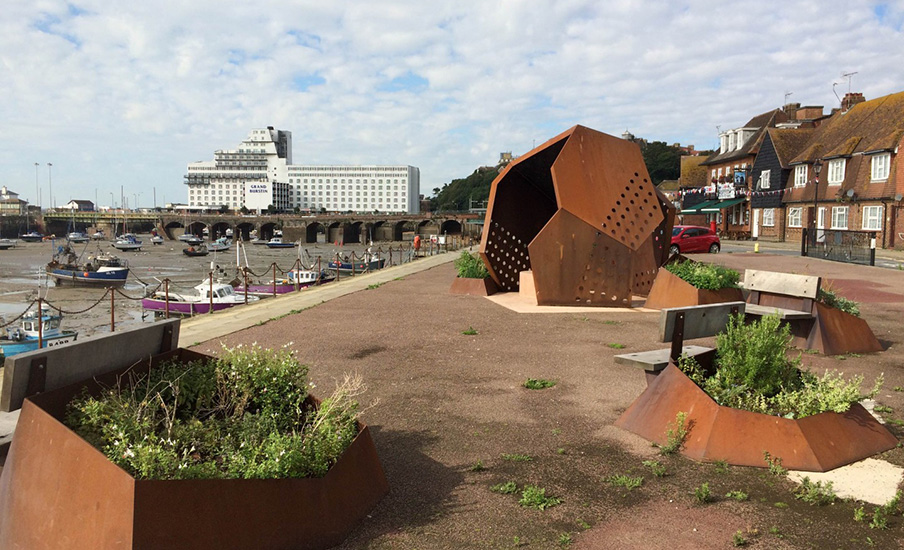Sarah Staton
Sarah Staton
Steve, 2014
Sarah Staton’s work has become increasingly prominent and admired in the UK over the past decade, presenting a beguiling mixture of traditional craft techniques with cutting edge technology. Her grounded sculptural forms occupy an edgy aesthetic territory between use value and sheer visual pleasure. She often collaborates with other artists, designers, architects and engineers, and is a natural animator of public space.
For Folkestone Triennial 2014, Staton has developed Steve, conceived as a 'people friendly sculpture' or a personified sculptural pavilion, and placed on The Stade. The Stade was originally a working area alongside ships berthing in the harbour, but now for the most part it has been given over to leisure and tourism. This location provides a great home for Steve, conceived as a monument to a person of the future.
Steve is fabricated from large scale, articulated plates of Corten steel arranged to define a volume with a hole through the middle, or to form a small pavilion, its sculptural language playing on the tropes of machismo seen in monumental public art in the tradition both of Henry Moore and Richard Serra. In addition, Steve is set among a group of three seating benches hybridised with planters – Steve's 'children' – also made from steel and producing a supply of edible costal plants destined for use in the local restaurants.
Sarah Staton was born in 1971 in London and lives and works in Sheffield and London, where she has recently been appointed to the staff of the Royal College of Art. Staton has been commissioned to create many artworks for the public realm in Europe and the UK including; Sheffield Sevenstone, (2007); Guinevere’s Pavilion (2008); Artisan Apartments (2008); Crucible Theatre (2010); New Art Gallery Walsall (2012); Harold and Maude at Hanningfield Reservoir, Essex (2014).
Audio guide
Video
Other Profiles
- Banksy
- Alex Hartley
- Amina Menia
- Andy Goldsworthy
- Diane Dever & Jonathan Wright
- Emma Hart
- Gabriel Lester
- Ian Hamilton Finlay
- John Harle, Tom Pickard and Luke Menges with the Futures Choir
- Jyll Bradley
- Krijn de Koning
- Marjetica Potrč and Ooze Architects
- Michael Sailstorfer
- muf Architecture/Art
- Pablo Bronstein
- rootoftwo
- Something & Son
- Strange Cargo
- Tim Etchells
- Will Kwan
- Yoko Ono
